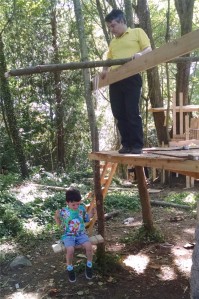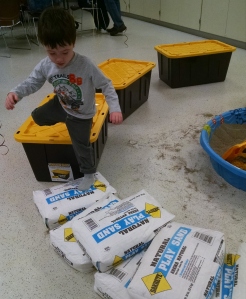In a separate post, I told all about the Adventure Playground on Mercer Island. In this post, I want to share a few stories from our trip there to illustrate some of the learning opportunities it presents.
Responsibility for Others
We visited with our son, who is five. He saw this slide in the distance.
He immediately ran over to play on it. There was an older boy there – maybe 10 – 12. He warned my son – “be careful, it’s not stable.”
The boy had started to remove the nails that were supporting the slide, because his family wanted to move it over to a more stable platform that they were working on.
My son was very sad about not being able to use the slide. The older boy told him he’d fix it – he pounded back in the nails he had just pulled so my son could use the slide. I told my son I wasn’t sure it was safe, because the bottom of the slide was propped precariously on a couple boards, with some loose boards just beyond the slide. I asked him to slow himself down on the first time down the slide, and once we knew it was reasonably stable, we cleared away the loose wood, and let him take 3 full speed slides, then we moved on so they boy could return to his work of re-locating the slide.
I thought this was a great example of a tween who was paying attention to and looking out for younger children. He knew that with the joy of risky play that the playground offers, we also have responsibility to keep others safe. And he knew that in a communal space, sometimes you change or pause your plan to make sure other kids are having fun too.
Risk Assessment
At a typical playground with mass produced equipment, it’s all been carefully designed and tested to be as safe as possible. That’s not the case at the adventure playground! This stuff was all knocked together by kids! It was a good opportunity for my 5 year old to learn how to watch out for hidden dangers: he learned to test for wobbly boards before going onto a platform, to be careful to stay in the center of high platforms without railings, and to look for protruding nails before going under something (note the third picture below, which has a random cluster of nails poking down in the middle of a board, for no real reason… this is at about head height for an adult.)
My son found one “balance beam” catwalk he really wanted to cross. It was about 6 – 8 inches wide, which would normally be easy for him. But it was also 5 feet up in the air. He was wise enough to realize this was not a good thing for him to attempt.
Problem-Solving / Engineering
My son wanted to make the “bridge” wider so it was safer to cross. But, we looked at the support platforms at each end, and there was just no way to make it work.
I suggested a hand rail, which he could use to stabilize himself, and he liked that idea. But this was a long span (8 feet?). We searched around and realized it was longer than any of the planks that were available. We thought about a rope handrail, but didn’t think it would provide enough stability. Then we looked around on the ground and found a really long branch. Perfect!
My husband, my son and I worked together to lift the branch up high. We were able to brace it in multiple places on tree branches. Then we scavenged for some ropes to tie it in place.
Then, my husband tested it, then made some minor adjustments, and then my son got his chance to cross the bridge – it’s a success!
This was a fabulous example of the engineering process in action: find a problem, brainstorm solutions, test available materials, build a prototype, test it, refine it – the problem is solved! My son learned a lot in the process, and was very satisfied with the results. The idea that he could help build something big and real that other kids could use was very empowering to him.
Taking Ideas and Improving Them
We walked around and played on other people’s structures for a while, and my son found this swing:

He is a huge swing fan, so couldn’t wait to try it. But it was a big disappointment. Instead of hanging flat, it tended to tilt up to 45 degrees forward and basically dump you off of it. It also didn’t have much of a swing radius.
We decided to build our own swing. We went back to the platform where we’d added the handrail. The handrail branch was so long that about 3 – 4 feet of it hung off over the end of the platform, at the perfect location and height for a swing support!
But, we’d installed it with the skinny end of the branch at that end. So, we uninstalled our handrail, flipped it over (tricky to do with a branch that must have been 15 feet long or more) and re-installed it with the fat end hanging over the end.
We found rope and a board for the seat, and started to build a swing. The board had four nails pounded through it, near each of the four corners – I started to take them out, but then realized that we could use them to stabilize the swing. So, as I tied the rope around the board, I poked the nails through it, then pounded them down to hold them in place.
Stringing the swing up was a little tricky, because we didn’t have any scissors, knife, or anything to cut the rope with, so it had to be one continuous loop. Once it was installed, again, my husband tested first, figuring if the swing could hold his weight, it was safe for kids. The branch support wobbled back and forth a bit as he swung, so we found some straps to tie it down better, then my son got to test it. Another building success!
Because my son is such a huge fan of swings, he was so excited that we had built a swing together! He shouted to the kids who were working nearby to look at it. He ran over to some other kids to invite them to come try it out. But they were busy working and didn’t come, so he came back and tested it more. A grandma who was supervising those kids came over and checked it out and shared my son’s excitement with his creation.
Competence and Empowerment
We saw similar excitement throughout the adventure playground, and lots of kids who were glowing with the empowered satisfaction of having BUILT SOMETHING.
Modern American kids don’t get a lot of experience with making real things, although they may do virtual building in Minecraft for hours.
These kids all built real structures that they could climb on and play on, and they felt competent, powerful, creative, bold. That sense of accomplishment is the best thing about the adventure playground, I think. And it’s something they carry out of the playground to increase their confidence at taking on other tasks.














